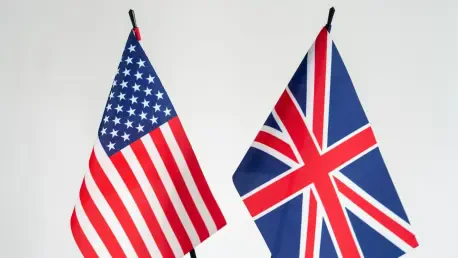The announcement of a groundbreaking trade agreement between the United States and the United Kingdom marks a pivotal moment in international trade relations, signaling a new chapter under the leadership of U.S. President Donald Trump and U.K. Prime Minister Keir Starmer. This strategic trade deal is destined to underline the longstanding and robust bilateral relationship between the two nations, with the potential to mitigate the economic challenges previously erected by Trump’s tariff measures. The agreement further aims to bolster U.S. market access abroad and fortify the existing economic ties between these historic allies. With the changing dynamics of global trade, both the U.S. and the U.K. have exhibited a keen interest in harnessing opportunities to reinforce economic collaboration, striving for a shared future amidst the complex landscape of international commerce. Amidst historical commemorations and economic aspirations, this trade deal emerges as a testament to enduring partnerships rooted in shared history and mutual interests. As the U.S. and the U.K. push forward, attention centers on how this agreement could shape the strategic economic landscapes moving into the next decade.
Promising Prospects for Bilateral Trade
In examining the mutual benefits expected from the newly proposed trade deal, it becomes evident that both the United States and the United Kingdom stand to gain considerably. From the U.S. perspective, the deal anticipates an increased export of beef and ethanol to the U.K., with assurances of streamlined customs processing for American products, thus enhancing the competitive advantage of American goods in the British market. Conversely, Britain gains significantly by having tariffs on its cars, steel, and aluminum either reduced or entirely eliminated, fostering increased competitiveness of British goods in the U.S. market. Specifically, the deal proposes a reduction of tariffs on U.K. cars from 27.5% to 10%, completely removing the 25% tariff on British steel. This move is expected to bolster the British automotive and steel industries, providing a substantial boost to the British economy, which has been navigating the complexities of the post-Brexit landscape. As both nations eye the prospective economic growth stimulated by this agreement, attention turns towards the logistics of implementation and the potential ripple effects across other industries reliant on these significant exports.
The timing of the announcement carries symbolic weight, coinciding with the historical commemoration of the World War II victory in Europe, which reaffirms the enduring partnership shared by the United States and the United Kingdom. British Prime Minister Keir Starmer highlighted the significance of this deal as a seamless continuity of collaborative spirit between these two nations, akin to the unified efforts witnessed during trying historical epochs. The historical context serves not only as a backdrop but as an undercurrent of the shared values and enduring alliances that continue to drive both nations forward in pursuing mutual prosperity and global stability. As these nations commemorate past victories and forge pathways for future trade success, the trade deal stands as a testament to the abiding economic and diplomatic ties that have long bound them together, with collective aspirations of continuing this collaborative trajectory into the future.
Navigating the Complexities of Brexit and Beyond
The journey towards finalizing this landmark trade deal has been intertwined with the broader context of the United Kingdom’s decision to leave the European Union. Since Brexit, the U.K. has sought to negotiate its own trade agreements, independent of the EU framework. Former Prime Minister Boris Johnson had earlier championed a U.S. trade deal as a crucial incentive for Brexit, promising newfound economic autonomy and opportunities that such an agreement would afford. However, initial progress in negotiations proved challenging, particularly under the administration of President Joe Biden, whose cautious stance on Brexit introduced additional complexities. It was only after Trump’s reelection that negotiations gained renewed momentum, moving with a sense of urgency and strategic alignment. As the trade deal advances, attention centers on how this agreement can serve as a blueprint for future negotiations, showcasing the potential for amicable and mutually beneficial resolutions outside established multilateral frameworks.
Central to the trade negotiations has been the effort to mitigate or wholly repeal previously imposed tariffs, notably those on U.K. cars and steel, which Trump had initially increased during his first presidential term. Auto exports to the U.S. form a vital segment of the U.K.’s export economy, with the U.S. representing a prime market for British automobiles. From a strategic viewpoint, this trade deal is poised to play a crucial role in sustaining and expanding the U.K.’s export markets amid fluctuating global trade conditions. As Britain and America move towards finalizing the trade agreement, the U.K. remains focused on crafting a strategic economic path forward post-Brexit, identifying new opportunities for bilateral cooperation in this evolving global landscape. With Brexit serving as both context and catalyst, the envisioned trade partnership between the U.S. and the U.K. exemplifies the dynamic interplay of negotiation, economic strategy, and international relations in contemporary trade diplomacy.
Strategic Implications and Future Considerations
President Donald Trump’s broader economic agenda, which has sought to “rewire the global economy” by imposing stringent import taxes to bolster domestic manufacturing, provides a notable backdrop to this trade agreement announcement. The move towards more balanced trade relations with the U.K. aligns with a critical reevaluation of global trade practices, underscoring significant issues such as persistent trade deficits. Apart from the U.K., the U.S. continues to experience trade imbalances with other major trade partners including Canada, Mexico, and notably China. High tariffs on Chinese goods remain a particular area of contention, illustrating the ongoing complexities and tensions within the realm of international trade. Despite these challenges, the proposed trade deal with the U.K. embodies a step towards fostering more equitable trade relations while addressing overarching economic imperatives. As the U.S. turns towards crafting new trade partnerships, the U.K. similarly seeks to expand its global economic footprint, evidenced by recent trade agreements with other nations such as India and concerted efforts to resolve trade barriers with the European Union.
The economic opportunities arising from this strategic trade deal are numerous, yet its ultimate impact will hinge on the successful conclusion and execution of the agreement. The anticipated benefits underscore the importance of adaptive trade strategies in navigating today’s intricate global market environment. Not entirely centered on economic gains, the deal also reflects a broader narrative of evolving international relations that are marked by geopolitical realignments and shifting dynamics. The attention now pivots towards the final terms of the agreement, which not only promise economic implications but also reflect enduring diplomatic relations. Stakeholders from both countries, along with the global community, will be watchful of how this trade deal and subsequent partnerships influence trade policy in the years to come. This pivotal trade initiative signifies an era that may redefine the contours of global trade and economic diplomacy, offering a glimpse into potential pathways for cooperation, competition, and conflict resolution on the international stage.
Towards a New Economic Landscape
The groundbreaking trade agreement between the United States and the United Kingdom marks a significant milestone in international trade, ushering in a new era under U.S. President Donald Trump and U.K. Prime Minister Keir Starmer. This strategic deal underscores the enduring and resilient bilateral relationship between these two nations, aiming to alleviate economic pressures caused by Trump’s previous tariff policies. The agreement seeks to expand U.S. market access globally and strengthen established economic ties between the historic allies. Amid shifting global trade dynamics, both countries are eager to leverage these changes to reinforce economic cooperation, aspiring for a shared future in the complex realm of international trade. This deal stands as a testament to enduring partnerships forged through shared history and mutual interests. As the U.S. and U.K. advance, focus lies on how this pact could transform strategic economic relationships in the coming decade, highlighting its potential impact on future commerce.









